Enclosure
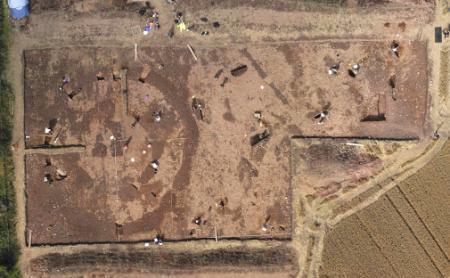 A circular enclosure located immediately to the northwest of the palisaded enclosure was excavated in 2010. Defined by two concentric ditches this enclosure is morphologically distinct from the nearby henges. The inner ditch was segmented while the outer ditch had two entrances, one in the south-east and the other in the south-west. It is likely that the outer ditch supported large upright timbers. Correlating to a large anomaly in a gradiometer survey conducted prior to the excavation, a large igneous boulder was revealed just within the south-west entrance of the outer ditch. The boulder may have originally been standing at the entrance, but at a later date had been pushed over and buried in a deep pit below the level reached by the modern plough. A single fragment of a lead object which possibly dates to the Roman Iron Age was the only find from the ditches. Charcoal from the ditch fills may be radiocarbon dated which will help to develop a chronology for the site.
A circular enclosure located immediately to the northwest of the palisaded enclosure was excavated in 2010. Defined by two concentric ditches this enclosure is morphologically distinct from the nearby henges. The inner ditch was segmented while the outer ditch had two entrances, one in the south-east and the other in the south-west. It is likely that the outer ditch supported large upright timbers. Correlating to a large anomaly in a gradiometer survey conducted prior to the excavation, a large igneous boulder was revealed just within the south-west entrance of the outer ditch. The boulder may have originally been standing at the entrance, but at a later date had been pushed over and buried in a deep pit below the level reached by the modern plough. A single fragment of a lead object which possibly dates to the Roman Iron Age was the only find from the ditches. Charcoal from the ditch fills may be radiocarbon dated which will help to develop a chronology for the site.
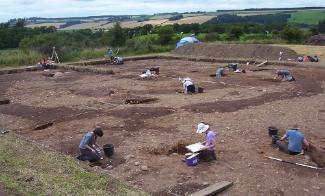
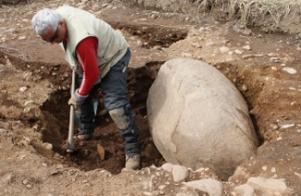
At the heart of this enclosure were three adjoining stone coffins, a triple cist. The central cist was up to 0.7m deep and constructed of large thin slabs set on edge. The side cists were not as deep and were lined with smaller stones. No human remains survived within these cists, although there was a possible body stain within the central cist. Phosphate samples may help to detect the position of a body here. Two flint flakes were found within the northern cist and a flint arrowhead was found within the central cist. These finds suggest that the burials may date to the Bronze Age. In a nearby pit a largely complete but shattered Beaker pot had been deposited.
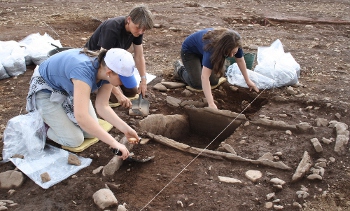
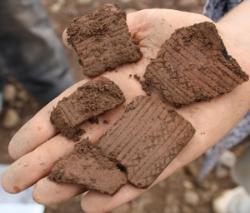
Located between the enclosure and the avenue to the palisaded enclosure were three large oval-shaped pits roughly equidistant from one another. One, located just outside the enclosure, contained substantial chunks of charcoal and carbonised cereal grains and was interpreted as a corn-drying kiln. Another of these pits also contained notable amounts of charcoal, where the third was largely devoid of charcoal.
An unstratified segmented blue bead possibly dating to the Norse period was also found on this site.
Report Links
- 2010 FN10.05a DSR
- Geophysical Survey

